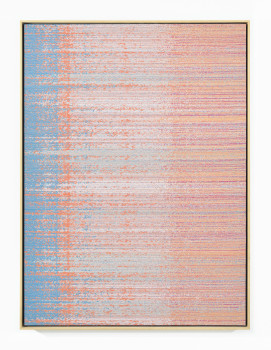
Sourced from the multiple architectonic and technological realities that exist in Warsaw, the subjects of this exhibition—machine, book, and body—are unseen. Instead they provide the underlying technical material for the hardware-laden sculptures and abstract woven textiles in AIR. Together the objects intimate a still obstinate and unreadable body in transformation. Skin perforated. Mind laced. Input ready. Configured for performance—work, pleasure, war. Not yet fully machine.
Since the eighteenth century, the machine has been used as a figure for understanding the body and society with a horizon for total convergence. The works in the exhibition materialize the evolution of this figuration and consider the political imperative of this body-machine complex.
The sculptures track the production of the bodily subject within the soft power of computational life—where coercion is replaced by contactless, ambient pressure. Arranged in an array outlining body meridian points, Force Touch, is a large-scale wall sculpture of embedded air jet diffusers emitting forced air into the exhibition space. The work relates to the haptic technology used for touch screens and track pads, mediating skin and machinic surface. An encounter of force and pressure.
The wood Pranayama sculpture punctured with chromed Jacuzzi jets is presented as an artifact—a product of rigid orthotic discipline and inner spiritual practice. The mask-like form, derived from external medical devices used to modify the shape and function of the body, also appears to be a conduit device. The control of breath (“prāṇa”) in Ayurvedic practice is the regulation of individual life force.
The selection of jacquard woven textiles Tajima’s Negative Entropy series are abstract images of two different technologies and sites of production: a book printing plant in Warsaw and a datacenter for cloud infrastructure provider in New York. The works are transmutations of field recordings made in these locations—sound information to material object. Jacquard looms are considered precursors to digital technology, underlining the intertwining histories of textile and digital production. A machine at the Argraf* plant printing a book about post-war ruin architecture in Warsaw is both a source and subject of the textiles. The unseen book here underlines the relationship between textile and text production. “Textus” in Latin can mean woven fabric, connective structure, and anatomical tissue.
*Argraf specializes in limited-run art publications and prints, including most of the books published by Raster.
Mika Tajima (born in 1975) is Japanese American artist, living and working in New York. In the last fifteen years she has exhibited at numerous museums in the United States and around the world, including Palais de Tokyo in Paris, the South London Gallery,the Aspen Art Museum, the Seattle Art Museum, and the Gwangju Biennale (2016). She cooperates with the galleries Van Doren Waxter in New York and Taro Nasu in Tokyo.
The exhibition at Raster is the first individual show of the artist’s works in this part of Europe. In 2007 her works were presented at the Ujazdowski Castle Centre for Contemporary Art in Warsaw in the group show Uncertain States of America.











